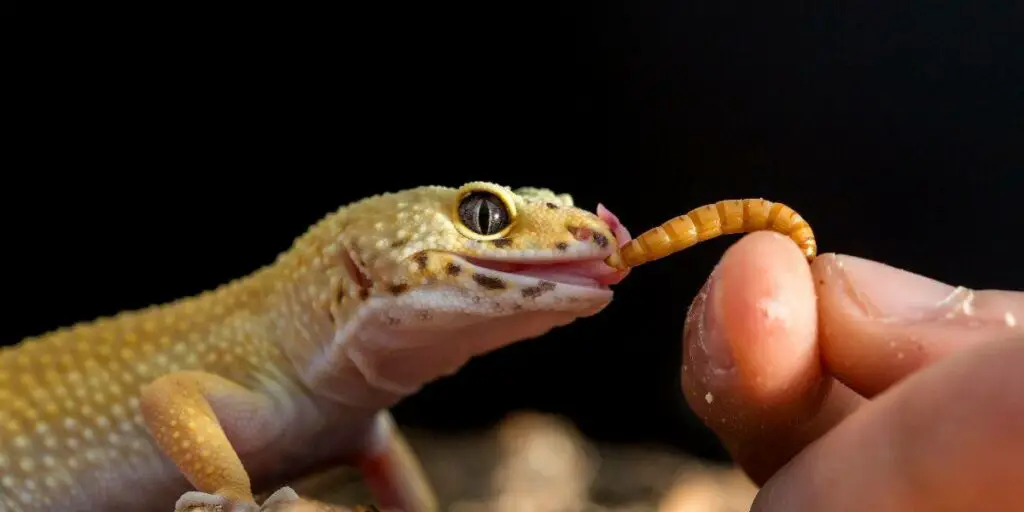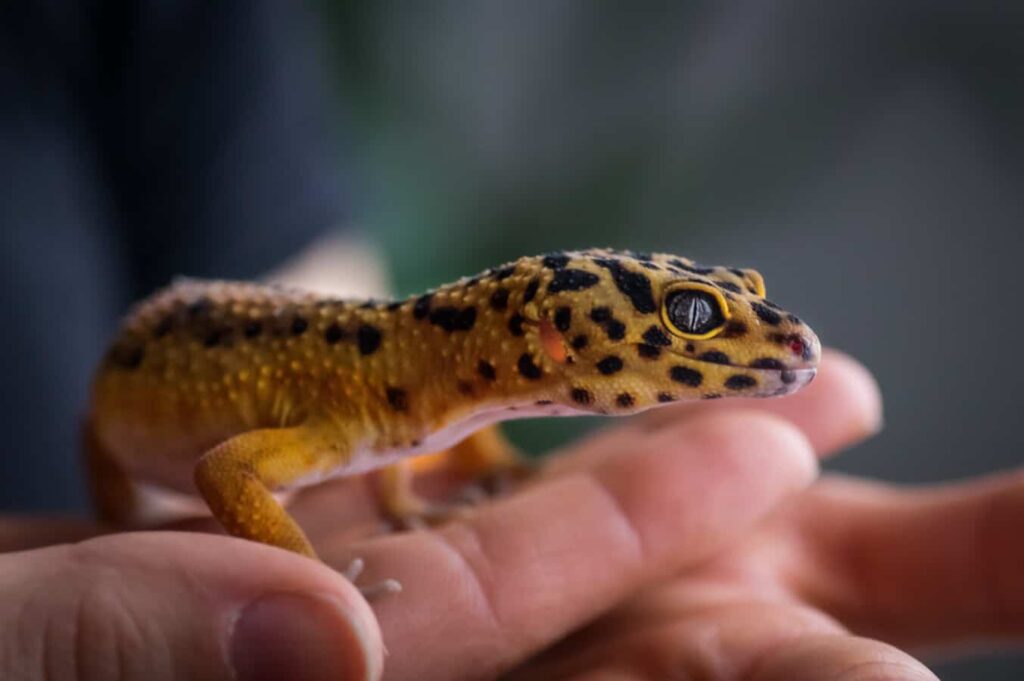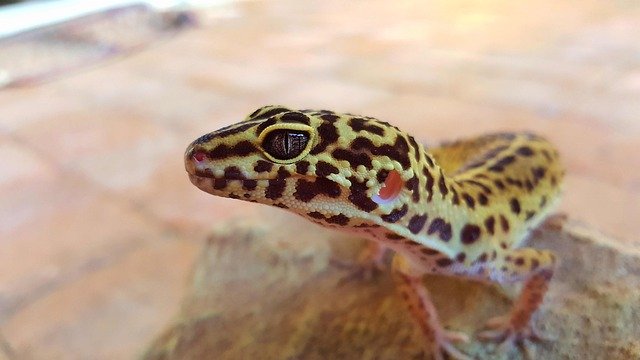While leopard geckos are used to the heat, originally coming from hot countries like India, owners might like to find ways of cooling them down. Unfortunately, one of the most common methods for this involves gecko owners putting their pets into a bath thinking that they will swim.
Leopard geckos cannot swim and you should never risk putting them into the water since these animals stand a significant chance of drowning. While it is true that leopard geckos can overheat, putting them in water is not a viable way of cooling them down.
With that in mind, let’s take a look at the swimming abilities of these animals and other ways that we can maintain a healthy temperature for our pets.
Can Leopard Geckos Swim?
Leopard geckos have no skills when it comes to swimming. Although, they can float on the water and this lulls owners into thinking that their pet is quite safe in the water.
In fact, sometimes, pet parents will install bowls of water or baths in their leopard gecko’s tank thinking that it will look nice and be beneficial to their lizard. But the opposite is true. The risk of a leopard gecko drowning is very high and for this reason alone, they should never be put in water.

While a floating gecko might look as though it isn’t putting in any hard work, the animal is having to exert itself in order to prevent itself from sinking. This can be tiring and if they have to do it for long periods of time, they may become too tired to continue, eventually giving in and drowning.
Swimming Can Be Stressful
Aside from the obvious risk of death, even if the lizard survives the ordeal, he may be affected by the stress of the experience.
Since these creatures cannot swim, their first reaction to being placed in water will likely be one of panic. One of the biggest problems is that this can result in a fear of water developing long after they have been taken out of the bath.
In some cases, geckos can become so frightened that they go into something of a slump. This may be displayed through a variety of unusual behaviors. You might notice that your leopard gecko refuses to come out of his hideout or his appetite may decrease, sometimes entirely.
If the experience of being in the water was particularly traumatic, it is not unheard of for leopard geckos to refuse further contact, even to the point of stopping drinking.
Stress can cause a variety of health problems in leopard geckos including those that come as a direct result of appetite loss.
However, most commonly, stress can cause leopard geckos to experience tail drops. This means that the tail will come off and while a new one will appear, it is often shorter. It is important to keep in mind that this is a natural process for a leopard gecko but it can result in even more stress.
Sickness
Aside from stress, being in water can cause a lot of health problems for leopard geckos. Most notably, they can develop respiratory conditions which, if left untreated, could be fatal.
If you notice that your leopard gecko has any symptoms of respiratory infections, you should have him seen immediately. However, even if your vet is able to treat the lizard, merely having a condition like this can shorten its lifespan by as much as a year!
These conditions are typically related to the rapid change in temperature but there may be other problems that come as a result of this. If geckos are repeatedly exposed to varying temperatures, there is a chance that it can impact their immune system.
How Do I Cool My Leopard Gecko Down?
As we have mentioned, one reason that owners might immerse their pet in water is if they feel that the animal is too hot. It is true that leopard geckos are susceptible to heatstroke and if this is not helped, it could end up in the death of the animal.
Signs that your leopard gecko is suffering from heatstroke tend to be a loss of appetite, panting, slower movements or not moving at all, digging, and struggling with pooping.
The best way to avoid heatstroke is to correctly maintain the temperature of the enclosure but in the height of summer, you may find that this becomes challenging and heatstroke may be the result.
Before you do anything else, you must make sure that you remove the leopard gecko from the tank and move him to a cooler location; without any water, unless it is for drinking.

Once in a cooler location, your pet should begin to regulate his body temperature. However, if things do not improve, you should have him seen by your vet.
Meanwhile, you will also need to explore the reason that things got heated in the tank. More often than not, it is a result of improper tank placement. Since you will have a heating system in place, there is no need to put the tank in direct sunlight as this could cause overheating.
You should also check the heating system to ensure that it has not malfunctioned before returning your lizard to his home.
Do I Need To Bath My Leopard Gecko?
Another reason that owners might expose their pets to water is to bathe them but the truth is that leopard geckos do not need to be cleaned this way.
Misting your leopard gecko will be more than sufficient and these animals will clean themselves.
When Should I Put My Leopard Gecko In Water?
There are times that you might need to supply your leopard gecko with water. While your pet might not like the experience of going into the water, sometimes, it is unavoidable.
However, when doing this, owners should be mindful to support their leopard gecko and hold him to prevent him from panicking. You should also keep in mind that these animals do not have a membrane over the ears, so there is a chance of water getting inside which could cause problems and discomfort down the line. To avoid this, do not submerge the lizard’s head in water past the ears.
The most common reason for bathing a leopard gecko would be to help with shedding. Unlike other reptiles, the leopard gecko may have a hard time shedding its skin and will often need help with this.
Bathing it in water can help to soften the skin and make it easier to come away. However, if you can get away with spraying him, this is far more preferable and will reduce stress on the animal.
Another reason that it would be acceptable to bathe your leopard gecko would be if the vent were to become blocked. This can sometimes happen in males during mating season.
At this time, the males secrete a waxy substance and for the most part, they can clean this by themselves. However, there are occasions where this will build up and your pet may struggle to remove it. In this instance, you may need to soak it in water to dislodge it.
Similarly, if your leopard gecko is suffering from impaction, which is comparable to constipation in humans, a warm bath might be enough to get his digestive system moving again.
Conclusion
Leopard geckos cannot swim. What’s more, they do not like being in the water and the experience alone can cause severe stress.
You should never put your pet into water unless it is to help his health. If you must do this, you should always supervise your pet and always keep the water shallow so that it does not cover his ears.




